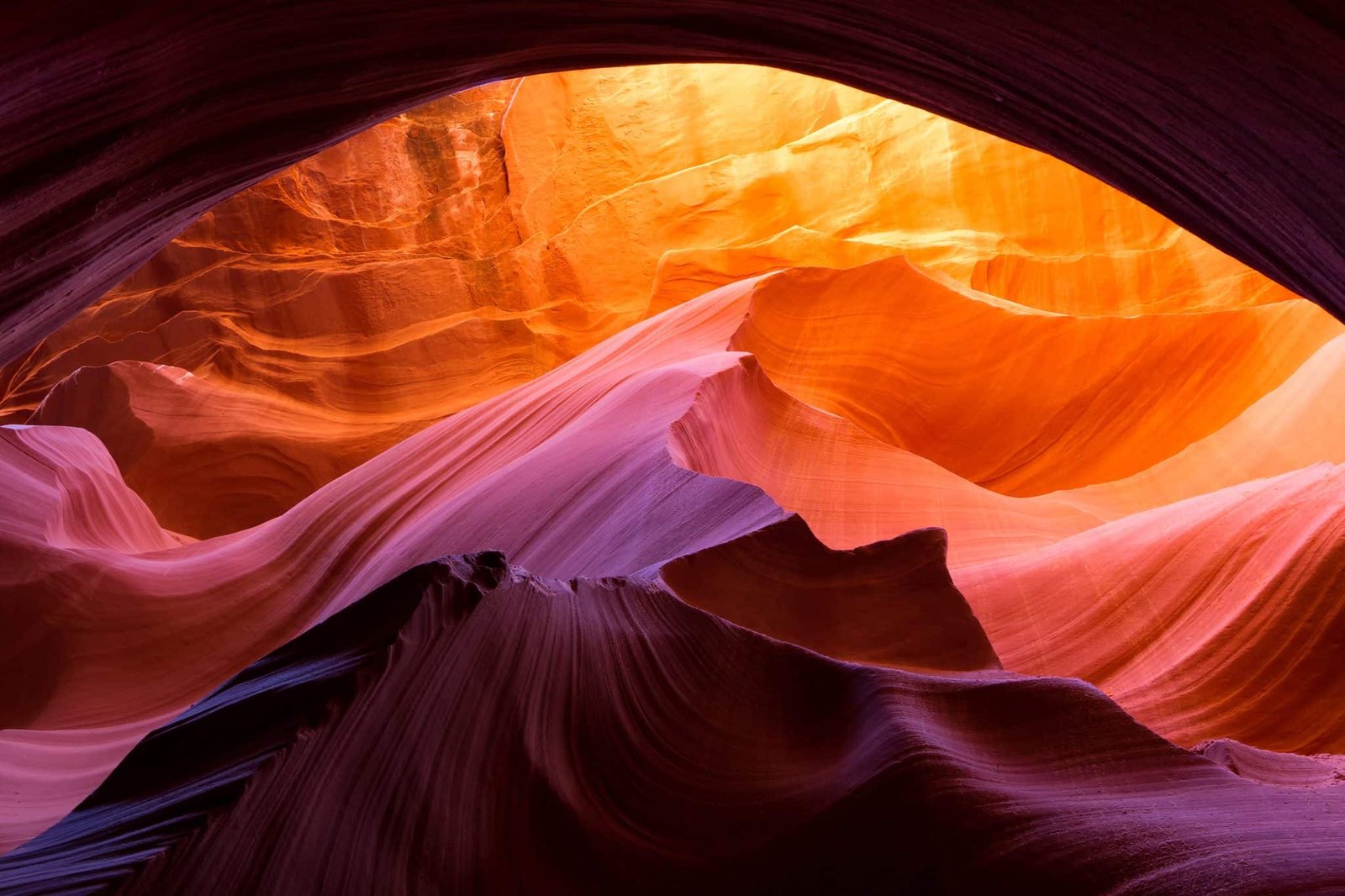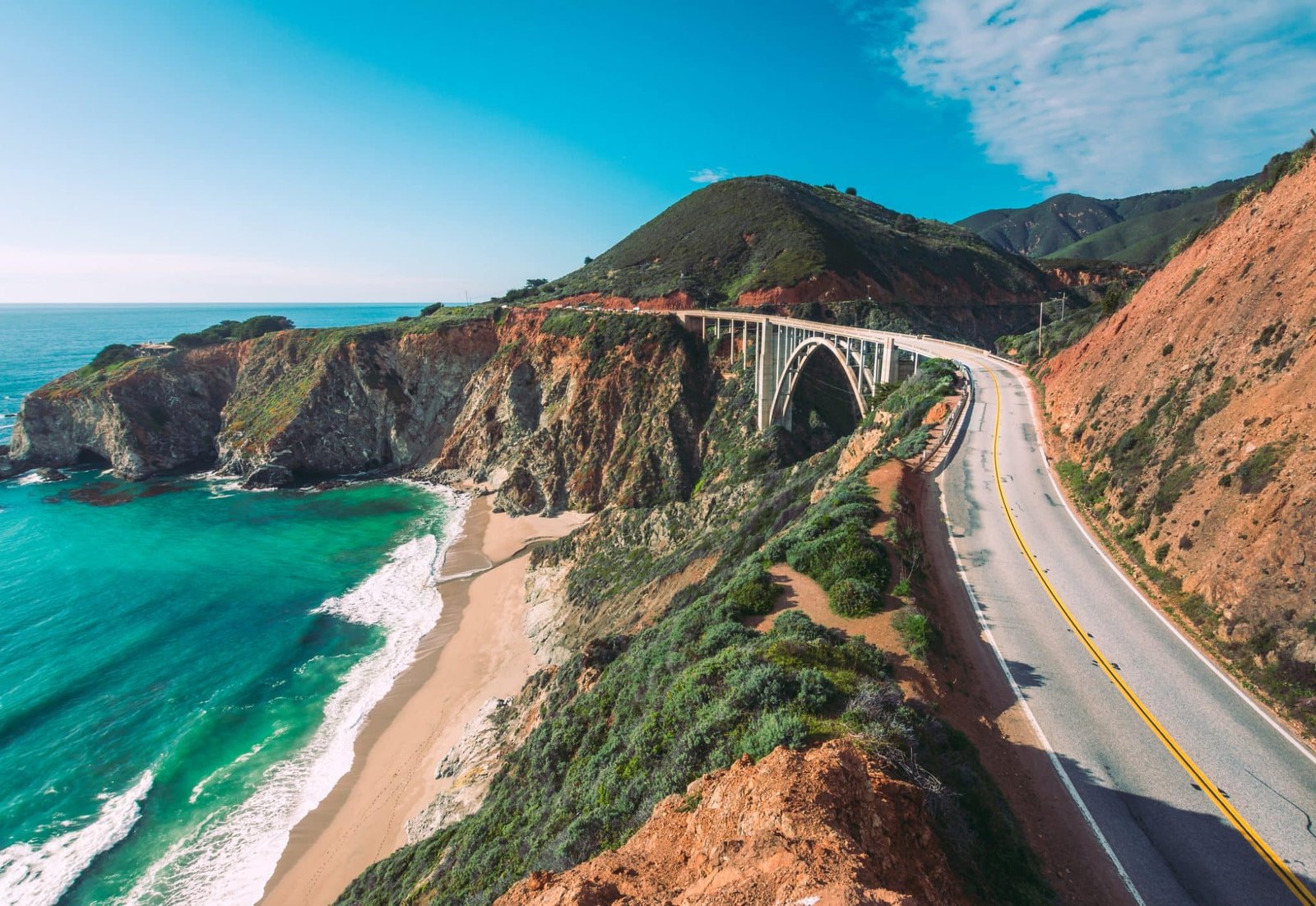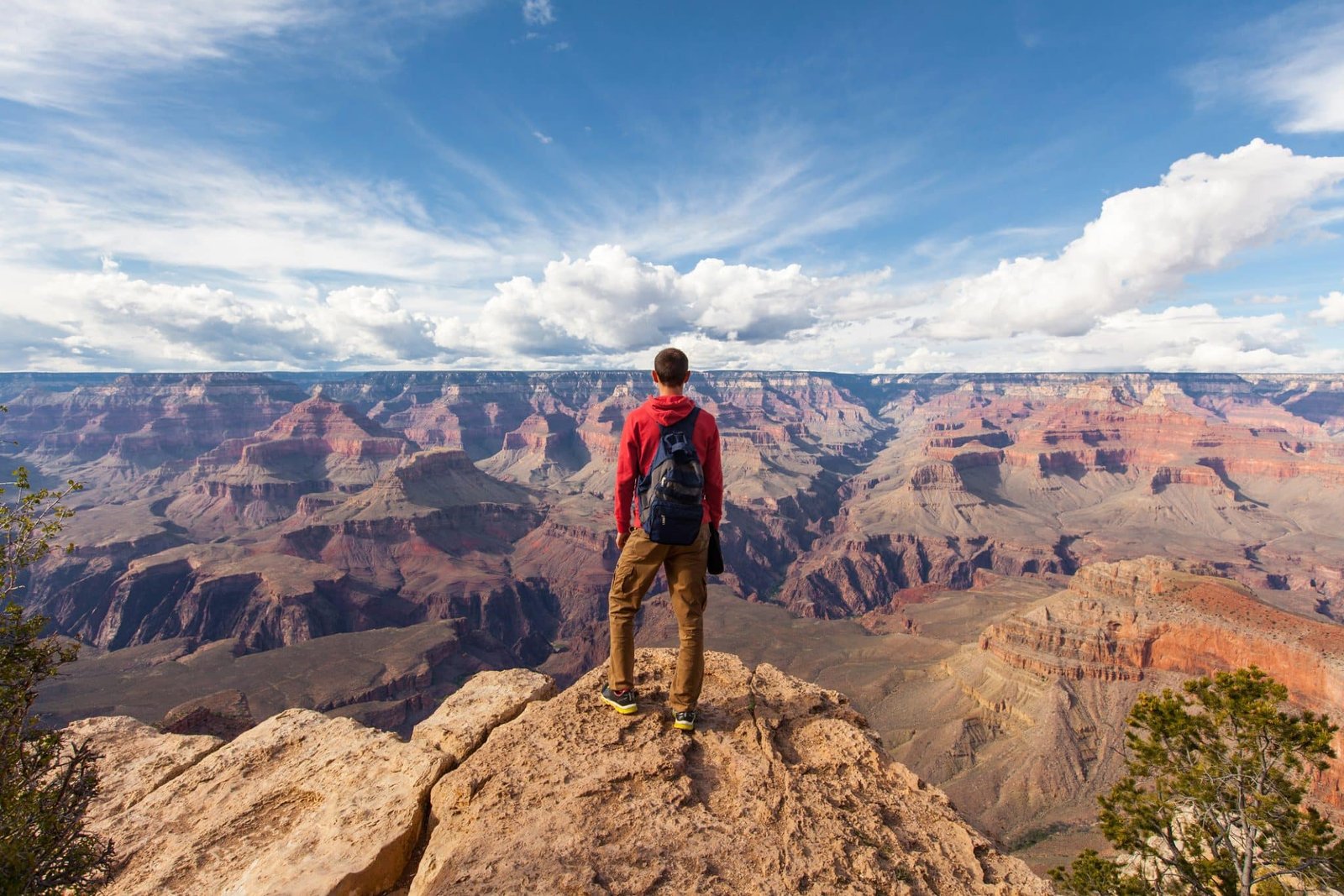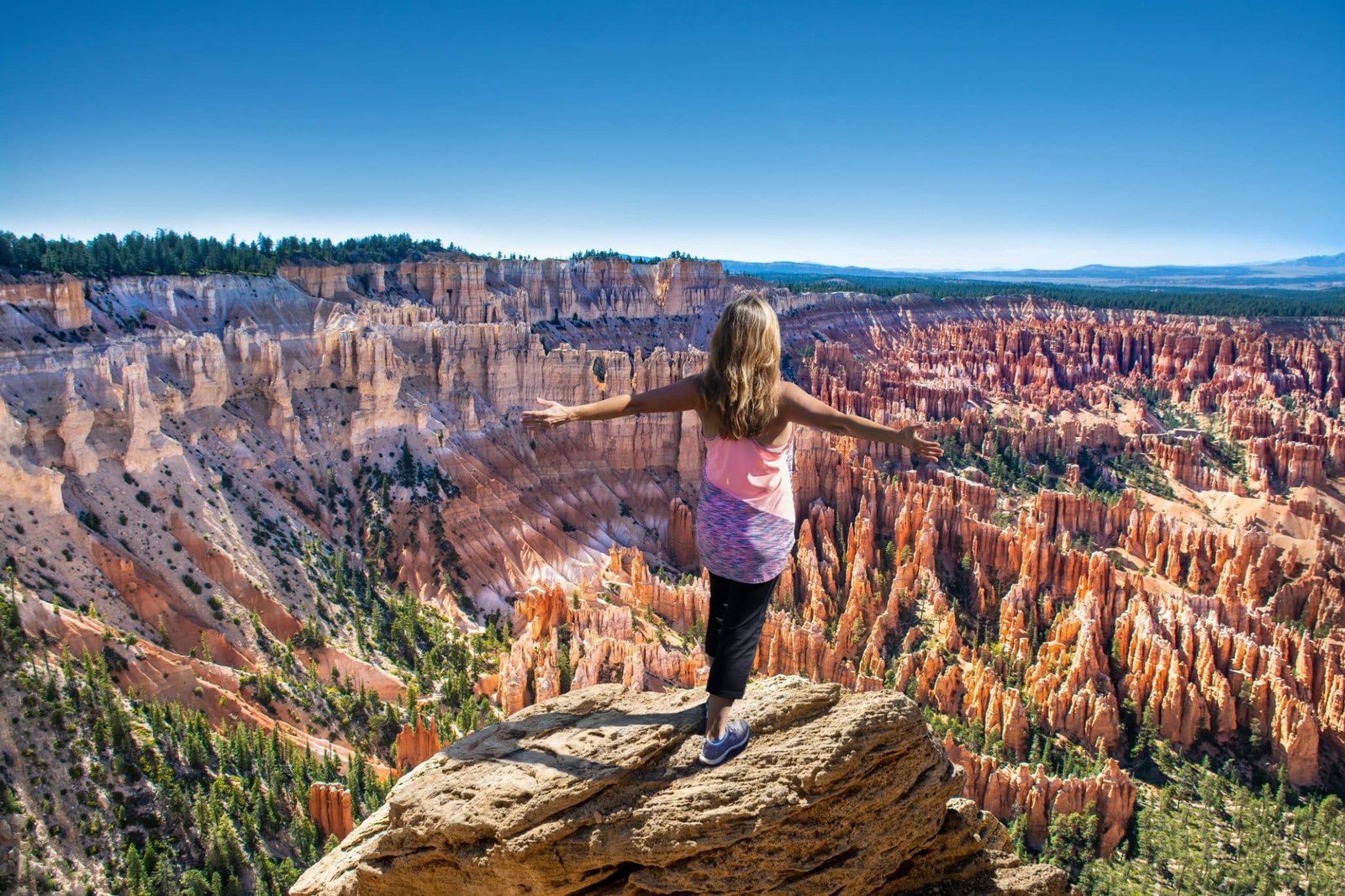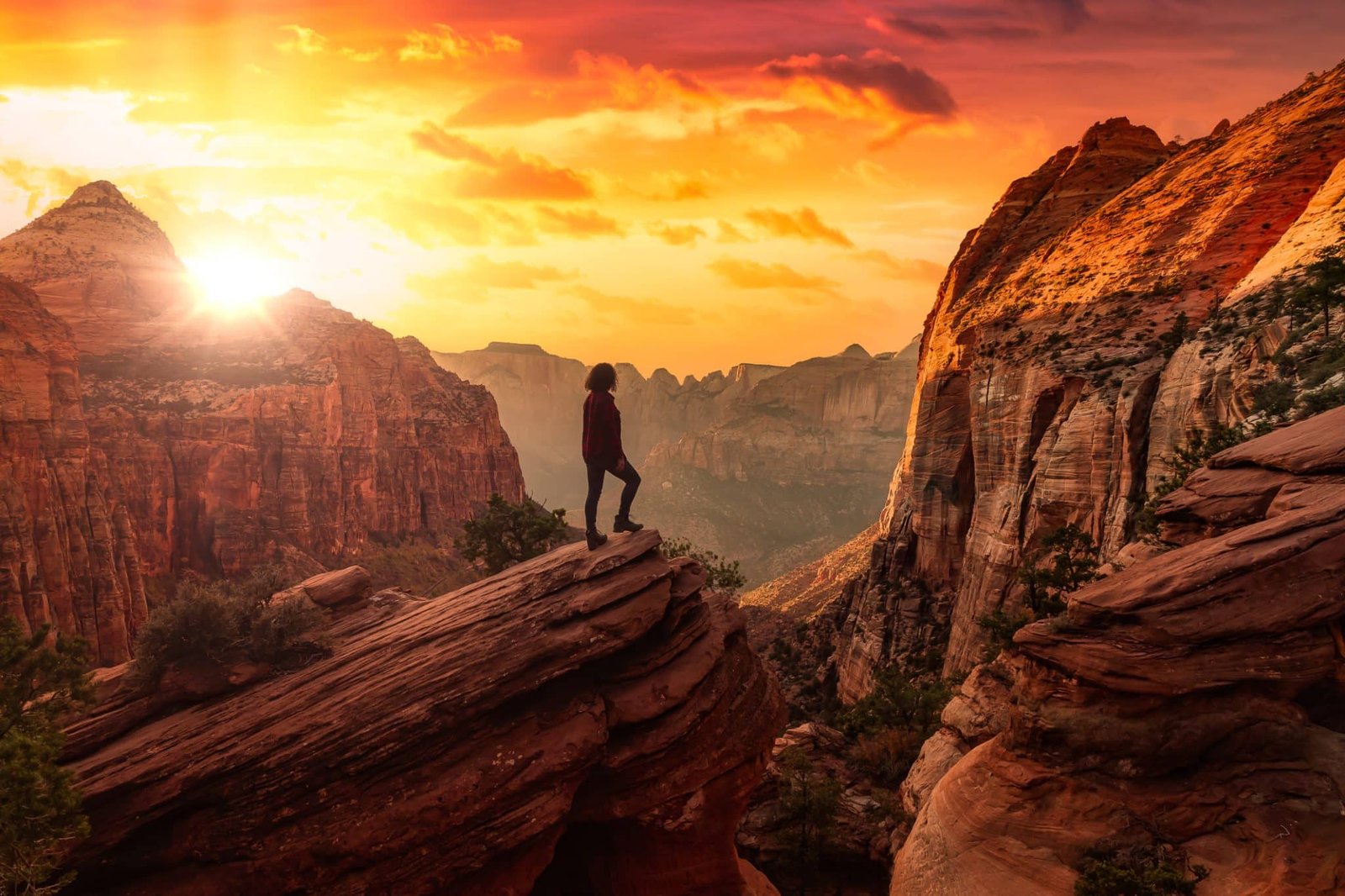Antelope Canyon vs Zion: An Honest Comparison To Help You Choose!
Antelope Canyon and Zion National Park are bucket-list hiking destinations due to their majestic natural splendor and superb walking trails.
While the two locations are a little over a hundred miles apart and can be visited on the same trip, if you are short on time or just looking for one of these spectacular locations to visit, it can be hard to work out which to visit.
That’s where we can help as both are actually quite different.
For example, Antelope Canyon is a slot canyon in Arizona, on a Navajo reservation east of LeChee. Located inside Lake Powell Navajo Tribal Park, Antelope Canyon is renowned for its narrow canyon with undulating angles and penetrative beams of light, and is a wonderful place for photography – arguably more so than Zion.
Zion National Park is located in Utah and is one of the state’s Mighty Five national parks. Its walking trails feature stunning scenery with high canyon walls in dramatic hues of red, orange, and brown. It’s the best choice for serious hikers, and we think it may appeal more to families too – as we’ll explain more on below.
But which of these two excellent hiking locations will take your breath away?
You’ll find that out right now, as we show which has the best hiking and photography opportunities, which is easier to get to, which is best suited for families, stargazing, wildlife and more!
CONTENTS:
- Which Is Easier To Get To?
- Which Has The Best Hiking?
- Which Has The Better Accommodation Options?
- Which Is Best For Photography?
- Which Is Best For Families?
- Which Is Better For Stargazing?
- What Time Of Year Is Best?
- Which Is The Better Choice?

Which Is Easier To Get To?
For both of these destinations, the nearest major airport is Harry Reid International Airport (LAS) in Las Vegas.
The drive from Las Vegas to Antelope Canyon takes about four and a half hours one way, and en route you will pass numerous other iconic Southwest viewpoints along the way, including the Grand Canyon’s South Rim.
As an alternative to flying via Las Vegas, Phoenix Sky Harbor International Airport (PHS) is a similar distance away from Antelope Canyon, with the drive taking an extra thirty minutes or so.
The drive from Las Vegas International Airport to Zion National Park is a little shorter than the drive to Antelope Canyon and would take close to three hours to complete.
Alternatively, if you are traveling from within the United States, you can look into flights into two smaller regional airports which are close to Zion National Park. St. George Regional Airport (SGU) and Cedar City Regional Airport (CDC) are both closer than Las Vegas’s international airport, with both airports being around fifty miles away from Zion.
If you have plans to visit both of these stunning locations, the drive between the two covers a distance of around 120 miles (200 kilometers), and would take close to two and a half hours.

Which Has The Best Hiking?
Before we assess the quality of the walking trails in each location, we should understand the lay of the land.
Zion National Park is an entire park that covers an area of 146,597 acres (229 square miles). Antelope Canyon, on the other hand, is a single slot canyon which is divided into two parts: Upper Antelope Canyon, which is about 200 meters (650 feet) long, and Lower Antelope Canyon, which is about 407 meters (1,300 feet) long.
Antelope Canyon forms a part of the much larger Lake Powell Navajo Tribal Park, which also includes Rattle Snake Canyon, Owl Canyon, and Mountain Sheep Canyon.
Overall, it will then come as no surprise that, in terms of the quantity of walking trails, Zion National Park has many more routes to offer walkers than Antelope Canyon has.
However, the surrounding area of Antelope Canyon also contains several other interesting walking trails. If you are planning a hiking vacation, it’s also worth checking out these other trails that are local to Antelope Canyon’s area.

Hiking In Antelope Canyon
Although it is one single slot canyon, there are two points within Antelope Canyon that you are able to visit: Upper Antelope Canyon and Lower Antelope Canyon.
The two sections also have more commonly used English names, with Upper Antelope Canyon also being referred to as “The Crack” and Lower Antelope Canyon being known as “The Corkscrew.”
Just to confuse you further, both sections also have a Navajo name, with the upper section called Tse’bighanilini, which means “the place where water runs through rocks,” and the lower section being Hasdez twazi’, which means “the spiral rock arches.”
Both of these sections are hikeable, but you must be accompanied by a tour guide, and advance reservations are necessary. Fees for the tour range from $40 to $50, and there are park entrance fees on top of that.
The trails are short, but very rewarding. Most people hike the lower section first, in the morning, and then follow this with a visit to the upper section. The idea is to hit the upper section around midday, as that is when the light beams penetrate the narrow canyon, allowing for stunning photography.
The tour to the upper section includes only a third of a mile of walking, and the lower section tour covers around half a mile in total.
Hikers looking for longer trails in the area can find more trail time on the ten-mile Page Rimview Trail. The trail leads to views of the canyonlands, Lake Powell, Glen Canyon Dam and dramatic rock formations, and is a little over ten miles away from Antelope Canyon.

Hiking In Zion
Zion National Park has many more trails that are much more accessible. There is also an entrance fee of $20 per person, and if you are taking a vehicle, there are also different fees for different-sized vehicles.
In terms of hikeable trails, Zion National Park has a plethora of choices. One of the most popular choices is the easy Canyon Overlook Trail. The one-mile walk takes around one hour and affords breath-taking views across the canyon.
If you’re looking to stretch the legs a little further, the Angels’ Landing Trail covers five and a half miles and takes between three and five hours to complete. This is the most popular trail within Zion National Park, and its final section involves scaling a narrow ridge high above the valley floor.
For serious hikers looking for a challenge, the section of the park known as The Narrows should be at the top of your list.
There’s a ten-mile round trip that takes you as far as Bog Springs, with a backcountry permit needed to go any farther.
This route takes in arguably the best scenery in the park, including a section known as Wall Street. Wall Street is the iconic section where the canyon gets very narrow and the sheer rock walls almost touch overhead.
While Antelope Canyon may have the most iconic scenery, Zion National Park is the place to go if you’re planning a serious hiking vacation to cover plenty of distance on the trails.

Which Has Better Accommodation & Camping Options?
As popular tourist attractions, both Zion National Park and Antelope Canyon have options for accommodation close by.
Antelope Canyon: Accommodations
If you want to stay close to Antelope Canyon, the best bet is to look at what’s available in Page, the nearest town. Page is a small town located on the southern shores of magnificent Lake Powell and is a mere ten-minute drive away from Antelope Canyon.
There are a range of accommodation options available – you can see those here – and a stay in Page also allows you to explore other natural wonders in the area, including Horseshoe Bend, the Glen Canyon Dam Overlook, and Antelope Valley.
The town has a friendly, welcoming community, and you can find hotels that are great for families, and many of them offer tours to Antelope Canyon.

Zion: Accommodations
For Zion National Park, there are also options. Especially as Zion has three campgrounds within the park’s boundaries: South Campground, Lava Point Campground, and Watchman Campground.
Staying in the campgrounds allows hikers to hit the trails nice and early in the mornings and beat the crowds.
If you are planning to camp, be aware that from mid-March through late November, the campgrounds get very full, and reserving a spot in advance is essential. The campsites are drive-up and allow a maximum of two vehicles, with only one RV or trailer allowed.
Aside from the campsites within Zion National Park, you also have the option of staying in a hotel in nearby Springdale.
Springdale sits at the entrance to the park and is geared up to accommodate tourists in town to visit the park. It’s a small town, but there are a few hotels to check out – you can check them out here – and there’s shuttle service into the park.
The campsites within the park do not have huge amounts of shade, and it can get very hot during the summer. If roughing it isn’t your thing, staying in Springdale might be a better fit.

Which Is Best For Photography?
Antelope Canyon is vaunted as the most photographed slot canyon in the world, and for good reason. If you are unfamiliar with its scenery, you have probably already seen pictures of it without realizing it.
Pictures of Antelope Canyon are pre-loaded screensavers on nearly every computer in the world, and its iconic Navajo sandstone patterns are very popular with Instagrammers.
Antelope Canyon does have very strict rules in place pertaining to what you are allowed to bring into the canyon. The list of banned items includes trippods, monopods, and selfie sticks. This is to protect the fragile sandstone environment.
That being said, the canyons offer some stunning photography opportunities, with the most sought-after shot being of the sunlight penetrating the Upper Canyon in beams.

With that said, it must also be noted that Zion National Park also offers some breath-taking scenery to snap away at. While the Upper Antelope Canyon has the most iconic shot of the two locations, Zion has a much larger array of vistas to keep nature photographers very happy.
Canyon Junction Bridge is considered the best location in Zion to photograph the Watchman as the sun sets, which is the most iconic view in the park. The Canyon Overlook Trail provides the best views over the entire main canyon.
Possibly the most well-known photographs of Zion National Park are taken on the Narrows Trail. Bear in mind that this trail is considered to be a challenging hike, and you should not push yourself past your physical limits just for a photograph.

Which Is Best For Families?
While both locations offer something for families, it will depend what type of family you are and what you are looking for from your visit to these beautiful parks.
If you’re a hiking family looking to hit the trails together, you will probably get more out of a visit to Zion National Park.
But if you are looking into which of the two places would make the ideal day trip for your family, well, that’s a much closer contest.
Antelope Canyon’s walks are very short, but the entire tour offers the chance to see the beautiful angles and light shafts on display, which are quite unique.
Also bear in mind that you have the other areas of Lake Powell Navajo Tribal Park—Rattle Snake Canyon, Owl Canyon, and Mountain Sheep Canyon—close at hand for exploring too.
If your children are very young, though, you should bear in mind that you will, in all likelihood, have to spend some time in the desert heat on the tours to the two sections. You may be required to wait outside the canyon while other groups are exiting. There is some shade, but there’s definitely no air conditioning.

Zion National Park has some beautiful scenery along its easier, short, more family-friendly trails too. You have a little bit more variety in the landscape at Zion too, and much better chances of spotting wildlife.
Zion is home to 289 bird, 79 mammals, 28 reptiles, 7 fish, and 6 amphibian species. Amongst the highlights are the California condors, Western rattlesnakes, Mexican spotted owls, and mule deer.
Aside from the family-friendly trails in Zion National Park—such as the Upper Emerald Pools Trail and the Riverside Walk—the nearby Grafton Ghost Town is great to explore with the kids.
That’s an abandoned pioneer town, which Robert Redford and Paul Newman graced with their presence when it was featured in Butch Cassidy & the Sundance Kid. Grafton is believed to be the most photographed ghost town in the western United States!
Another point to keep in mind if you are traveling as a family, especially if it’s a large family, is the price to enter these two parks. A visit to Zion National Park will cost significantly less in entrance fees for a large family. Considering that and the points above, we think Zion is probably a better choice for families than Antelope Canyon.

Which Is Better For Stargazing?
Both Zion National Park and Antelope Canyon have some opportunities for gazing at the stars with little light pollution.
In 2021, Zion National Park became certified as an International Dark Sky Park, a certification granted in recognition of the exceptional quality of the park’s night skies and because the park runs special atronomy-geared programs.
Zion National Park has installed night-friendly lights at the Zion Canyon Visitor Center, Zion Human History Museum, Zion Lodge, and its campgrounds, which direct light downward instead of casting it upward into the sky.
All this means that from within the park, you can have some amazing views of the Milky Way. And Zion is definitely the better option for stargazers.
Despite Antelope Park closing at 5 p.m., there are opportunities for keen astronomers to gaze at the Milky Way from inside a narrow slot canyon.
The nearby Ligai Si Anii Canyon can be visited as part of a Stargazing Night Hike. Looking up the striated sides of the canyon to see a slither of the night sky between them is a sight to behold!

What Time Of Year Is Best?
While both locations are open throughout the year, there are times that will be better to visit than others. And, again, it will depend on what you are looking for from your trip as to which time of the year will best suit your plans.
Unsurprisingly, the busiest times for both locations are when the schools are closed.
For Antelope Canyon, the busiest times are when the shafts of sunlight penetrate the narrow spaces at the top of the canyon.
Seeing these penetrating shafts of light is many people’s main goal when visiting the canyon, and the light beams only penetrate when the sun’s angle is correct. This happens around midday between the months of March and October.
If you plan to visit during these times, you will need to make a reservation well in advance, as tickets are limited. As the midday tours are the most popular ones, they also come at a premium, with tickets at this time of the day being a little more expensive than at other times.

Zion National Park is also a year-round attraction. As with Antelope Canyon, the summer months will also be the busiest here too.
While both locations are excellent to visit during the summer, when they are undeniably at their best (and busiest), Zion National Park is also worth a visit during the winter.
The winter brings a different feel and look to Zion, and if there’s any snowfall, the white blanket draped over the park allows for some stunning wintery landscape photography.
If you are planning a winter trip to Zion with the intention of hitting the trails, be sure to pack suitable protection from the elements, especially if you plan to visit the areas with a higher elevation.
For hiking in the winter, over-the-shoe traction devices on sturdy boots are highly recommended, and you should also prepare for nighttime temperatures that dip below freezing.

Antelope Canyon vs Zion: Which Is The Better Choice?
While both Antelope Canyon and Zion National Park offer the chance to marvel at nature and get out in the great outdoors, they are quite different from one another, and which one will suit your plans best will depend on you…
For those seeking a serious walking trip with plenty of miles of trails to explore, then you will probably enjoy Zion National Park more than Antelope Canyon.
The vast array of trails, from short and easy to long and arduous, means that there is something for every level of hiker, and all will get to see breath-taking scenery as they huff and puff their way along the trails.
If photography is high on your list of priorities, then you have a more difficult decision to make. While Antelope Canyon offers the chance for some stunning and unique nature photography, the majestic vistas on display in Zion National Park are also well worth schlepping your camera gear up and down the trails for.
Keen naturalists, although they will undoubtedly be impressed with the beauty of Antelope Canyon, will have a better time spotting iconic wildlife in Zion National Park.
The much longer walks and more diverse landscape in Zion allow for some stunning and occasionally rare wildlife encounters. Desert bighorn sheep, mule deer, peregrine falcons, and even the very occasional black bear await…
Both locations are iconic examples of the great outdoors in the United States, and both seldom disappoint.
If you’re struggling to come to a decision, you should also remember that these two locations are not a million miles apart.
With some careful time management and planning, you can easily fit both locations into your vacation plans, and you can even throw in a few more iconic US landscapes along the way, with the Grand Canyon and Bryce Canyon not too far away either…


